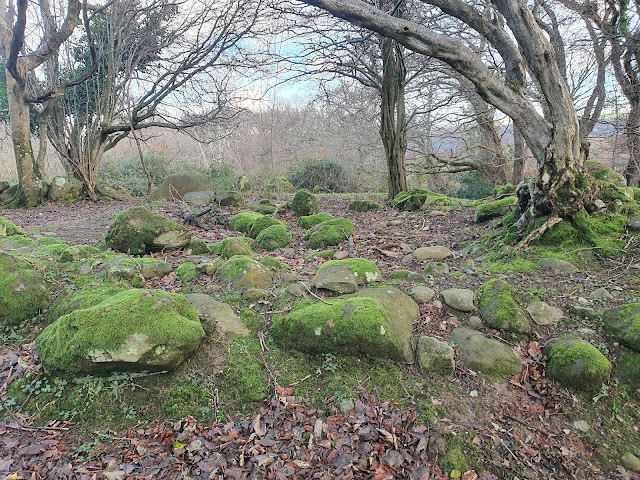What is undeniable is that the place has been in ruin for a very long time, with very little remaining but foundations. I've only found two references to it in the census, separated by twenty years. The house sits on the junction of the lane up to the mountain and the drive to Tyddyn Wern, at Ordnance Survey grid reference SH 7551 7023, but on the far side of the stream from the lane, so access would have been over the ford, which can be hard to cross at times in winter, and would have been even more torrential, perhaps, before the leat across the mountain was built, which reduced the flow of the stream.
Looking down the lane from the ford. Imagine this road as a track of stones and mud, and it's easier to understand why you might pay a toll to travel on a route that was better looked after.
From the modern concrete footbridge over the stream, the driveway to Tyddyn Wern can be seen leading away through an avenue of small trees. The route is a public footpath.
Just to the right of the track, beyond the modern gate, lie the remains of the gatehouse.
The track can be seen leading straight through arched trees, mostly hazel, with the building on the right.
This large stone seems to have been used as a gatepost at one time.
There are quite a few holes in this stone, which is a lot of effort to hang a gate.
The entirety of the ruins of the house, which seems to have been roughly square. It's impossible to tell how many storeys it would have been.
Gatehouse first appears in the 1841 census - the first census to be taken - listed, in order, Gatehouse, Mount, Tyddyn y Wern, Pen y Graig. The order of houses up the road is Mount, Tyddyn Wern (with the gatehouse at approximately the same height up the hill), Pen y Graig. In the 1851 census the house doesn't appear, but it is mentioned in the 1861 census, in order of Tyddyn y Wern, Cottage Gatehouse, Pen y Graig. In the 1841 census the inhabitants of Gatehouse are Margaret Price, 70, and Jane Williams, 20, dressmaker. In 1861, the house is listed as uninhabited, and doesn't appear in subsequent censuses. Perhaps it was also uninhabited in 1851, and not listed. Three houses are mentioned, unnamed, as uninhabited. Interestingly, the 1861 census lists the occupation of Aaron Roberts of Pen y Graig as 'farmer of 8 acres, highway collector.' Could this be related to the demise of the gatehouse?
The famous Rebecca Riots occured between 1839-1843, in part as a protest against toll roads but also against economic conditions. These protests were mainly in South Wales, but perhaps the gatehouse fell out of use during this time due to unrest over toll charges. Another BBC article says that the 'Turnpikes act of 1844 amalgamated Welsh trusts and reduced tolls.' Perhaps the railway built along the coast in 1848 also reduced traffic coming up over the pass of Bwlch y Ddeufaen to avoid the route around Penmaenmawr. Coflein reports that until 1772 'carriages previously used the sands at low tide' to get around the headland. This is some seventy years before the gatehouse may have fallen out of use, but the road around Penmaenmawr must have been precarious even after the new road was built, as these linked pictures show. Even in our modern age it can feel very exposed at times on this coast road.
This is all speculation about a building with very little historical fact attached to it. The scant facts are that the building was known as Gatehouse, that it sits on one of the four roads up to Bwlch y Ddeufaen from the Conwy Valley, which was a drover's route and possibly the route of the Royal Mail coach, and that after it was abandoned, Aaron Roberts was a farmer and 'highway collector,' when in 1841 he was an agricultural worker. (In 1851 the census seems rather confused. The house names are not in order and Aaron isn't shown in Pen y Graig, although he may simply have not been present that day.)
To the left of the house a wall curves around to form a small yard.
This really is a very small space, and presumably a lot of the stones have been robbed out for other purposes.
The wall on the other side of the track is particularly well kept near this house. Perhaps some of the house stones have ended up here?
Although in its day this house may have taken tolls from passing carts, in more recent years it has regained new life as a very exciting spaceship, and taken small boys on many trips into outer space.
Behind the house the curving yard wall continues to the stream. It's not a massive space, but a relatively good size for such a small house.
The amount of stones here suggest either another structure, or they are simply scattered from what was probably a wall to the left of the photo.
The stream which separates the house from the lane, with the modern concrete footbridge to one side.
Standing on the bridge and looking down at the flat width of the stream. The stream is shallow here, but at times of heavy rain the flow has been so strong as to make crossing the ford dangerous.
There is a single large, flat slab of stone under the water, surrounded by a reasonably intact area of cobbles. This is much easier to see in the summer, when the water is lower!
The track to the farm of Tyddyn Wern (from where the footpath leads into Rowen) is very picturesque at all times of year. Past Tyddyn Wern the footpath can be almost impassible when the bracken and brambles are high.
Looking up the lane, past the ford on the right.


















No comments:
Post a Comment